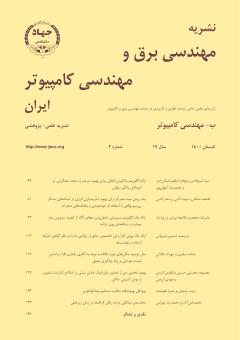پروتکل بهبودیافته مخابره مستقیم نیمهکوانتومی
محورهای موضوعی : مهندسی برق و کامپیوترزینب رشیدی 1 , منیره هوشمند 2 *
1 - دانشگاه بین المللی امام رضا (ع)
2 - دانشگاه بین المللی امام رضا(ع) مشهد
کلید واژه: رمزنگاری کوانتومی, رمزنگاری نیمهکوانتومی, مخابره امن نیمهکوانتومی, کنترلکننده,
چکیده مقاله :
برخلاف رمزنگاری کلاسیک که امنیت آن مبتنی بر پیچیدگی محاسباتی است، رمزنگاری کوانتومی دارای امنیت بیقید و شرط بوده که بر مبنای محدودیتهای فیزیکی تأمین میشود. تا کنون نسخه نیمهکوانتومی بسیاری از مسایل پروتکلهای مخابره امن کوانتومی پیشنهاد شده است. در این پژوهش به بررسی پروتکلهای نیمهکوانتومی پرداختهایم که کاربران بدون توزیع کلید، به صورت مستقیم به پیام محرمانه دست خواهند یافت. فاکتور مهمی که برای تحلیل عملکرد پروتکلهای ارتباط مستقیم امن کوانتومی به کار گرفته میشود، بازدهی میباشد. پروتکل پیشنهادی مخابره امن نیمهکوانتومی، در برابر انواع حملات کوانتومی بررسی شده است. در طرح پیشنهادی برای کدگشایی پیام محرمانه توسط گیرنده، نیاز به دنبالهای از تک فوتونها است که در مرحله اول توسط کنترلکننده تولید میشود. پروتکل پیشنهادی دارای بازدهی 50% است که نسبت به پروتکل قبلی که دارای بازدهی 66/6% است، بازدهی بالاتری دارد.
Unlike classical cryptography, where security is based on computational complexity, quantum cryptography has unconditional security, which is based on physical constraints. So far, the semi-quantum version of many of the problems of secure quantum communication protocols has been proposed. In this study, we examined semi-quantum protocols that allow users to access a secret message directly without distributing the key. An important factor used to analyze the performance of secure quantum direct communication protocols is efficiency. In this study, the proposed semi-quantum secure communication protocol against various quantum attacks has been investigated. In the proposed scheme for decoding the confidential message by the receiver, a sequence of single photons is required, which is first generated by the controller. The proposed protocol has a yield of 50%, which is higher than the previous protocol, which has a yield of 66.6%.
[1] M. Boyer, D. Kenigsberg, and T. Mor, "Quantum key distribution with classical Bob," in Proc. IEEE 1st Int. Conf. on Quantum, Nano, and Micro Technologies, ICQNM'07, pp. 10-10, Guadeloupe, French, 2-6 Jan. 2007.
[2] م. هوشمند و ش. حسنپور، "ارتباط مستقیم امن کوانتومی کنترلشده با هدف افزایش بازدهی،" مجموعه مقالات يازدهمين کنفرانس بینالمللی انجمن رمز ایران، 6 صص.، تهران، ايران، 12-11 شهريور 1393.
[3] G. E. Moore, "Cramming more components onto integrated circuits," Proceedings of the IEEE, vol. 86, no. 1, pp. 82-85, Jan. 1998.
[4] M. A. Nielsen and I. L. Chuang, Quantum Computation and Quantum Information, Cambridge University Press, 2001.
[5] T. P. Spiller, W. J. Munro, S. D. Barrett, and P. Kok, "An introduction to quantum information processing: applications and realizations," Contemporary Physics, vol. 46, no. 6, pp. 407-436, 2005.
[6] D. C. Marinescu and G. M. Marinescu, Approaching Quantum Computing, pp. 1-41, Pearson/Prentice Hall, 2005.
[7] M. Nakahara and T. Ohmi, Quantum Computing: From Linear Algebra to Physical Realizations, CRC Press, 2008.
[8] R. P. Feynman, "Simulating physics with computers," International J. of Theoretical Physics, vol. 21, no. 6/7, pp. 467-488, 1982.
[9] L. K. Grover, "A fast quantum mechanical algorithm for database search," in Proc. of the 28th Annual ACM Symp. on Theory of Computing, STOC’96, pp. 212-219, Philadelphia, PA, USA, 22-24 May 1996.
[10] P. W. Shor, "Algorithms for quantum computation: discrete logarithms and factoring," in Proc. IEEE 35th Annual Symp. on Foundations of Computer Science, pp. 124-134, Santa Fe, NM, USA, 20-22 Nov. 1994.
[11] S. Wiesner, "Conjugate coding," ACM Sigact News, vol. 15, no. 1, pp. 78-88, Jan. 1983.
[12] C. H. Bennett, G. Brassard, S. Breidbart, and S. Wiesner, "Quantum cryptography, or unforgeable subway tokens," Advances in Cryptology: Proceedings of CRYPTO '82, pp. 267-275, Santa Barbara, CA, USA, 23-25 Aug 1982.
[13] C. H. Bennett and G. Brassard, "Quantum cryptography: public key distribution and coin tossing," Theor. Comput. Sci., vol. 560, pp. 7-11, 2014.
[14] م. هوشمند، م. خرمپناه و ر. ساروقی، "ارسال محرمانه اطلاعات به کمک کیوبیتهای درهمتنیده،" مجموعه مقالات نهمين کنفرانس بینالمللی رمز ایران، 5 صص. تبريز، ايران، 24-23 شهريور 1391.
[15] X. Zou and D. Qiu, "Three-step semiquantum secure direct communication protocol," Science China Physics, Mechanics & Astronomy, vol. 57, no. 9, pp. 1696-1702, 2014.
[16] K. Thapliyal and A. Pathak, "Applications of quantum cryptographic switch: various tasks related to controlled quantum communication can be performed using bell states and permutation of particles," Quantum Information Processing, vol. 14, no. 7, pp. 2599-2616, 2015.
[17] Y. P. Luo and T. Hwang, "Authenticated semi-quantum direct communication protocols using bell states," Quantum Information Processing, vol. 15, no. 2, pp. 947-958, 2016.
[18] C. Shukla, K. Thapliyal, and A. Pathak, "Semi-quantum communication: protocols for key agreement, controlled secure direct communication and dialogue," Quantum Information Processing, vol. 16, no. 12, Article No.: 295, 2017.
[19] H. Lu, M. Barbeau, and A. Nayak, "Economic no-key semi-quantum direct communication protocol," in Proc. IEEE Globecom Workshops, GC Wkshps’2017, 7 pp., Singapore, Singapore, 4-8 Dec. 2017.
[20] J. Gu, P. H. Lin, and T. Hwang, "Double C-NOT attack and counterattack on ‘three-step semi-quantum secure direct communication protocol’," Quantum Information Processing, vol. 17, no. 7, Article No.: 182, 8 pp., Jul. 2018.
[21] C. Xie, L. Li, H. Situ, and J. He, "Semi-quantum secure direct communication scheme based on bell states," International J. of Theoretical Physics, vol. 57, no. 6, pp. 1881-1887, 2018.
[22] W. Zhang, D. Qiu, and P. Mateus, "Security of a single-state semi-quantum key distribution protocol," Quantum Information Processing, vol. 17, no. 4, Article No.: 2050013, 21 pp., 2018.
[23] L. C. Xu, H. Y. Chen, N. R. Zhou, and L. H. Gong, "Multi-party semi-quantum secure direct communication protocol with cluster states," International J. of Theoretical Physics, vol. 49, no. 1, Article No.: 1950004, 10 Jan. 2020.
[24] F. G. Deng and G. L. Long, "Controlled order rearrangement encryption for quantum key distribution," Physical Review A, vol. 68, no. 4, Article No.: 042315, Oct. 2003.

